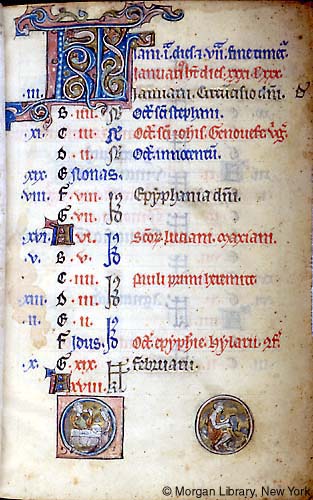
Accession number
MS M.101
Object title
Psalter (MS M.101).
Created
France, probably Paris, ca. 1276-1280.
Binding
Olive morocco by C. Lewis with arms of Henry Gee Barnard outside both covers and inside front cover, lettered: Missale Romanum; in maroon case lettered: Psalterium Davidis - Ms. on vellum executed in Beauvais, ca. 1250.
Credit line
Purchased by J. Pierpont Morgan (1837-1913) in 1902.
Description
280 leaves (1 column, 16 lines), bound : vellum, ill. ; 203 x 141 mm
Provenance
In 1483 was at Riez (Basses-Alpes) according to note on flyleaf; owned ca. 1830 by Henry Gee Barnard; purchased by William Morris from Ellis & Elvey in Dec. 1895 (signature on flyleaf); Richard Bennett (purchased from Morris's estate, 1897); Catalogue of manuscripts and early printed books from the libraries of William Morris, Richard Bennett, Bertram, fourth Earl of Ashburnham, and other sources, no. 20; purchased by J. Pierpont Morgan (1837-1913) with the Bennett Collection in 1902; J.P. Morgan (1867-1943).
Notes
Ms. psalter; written and illuminated in France, probably Paris, ca. 1270s.
The manuscript was thought to have been produced in Beauvais because there are saints in the calendar and litany peculiar to Beauvais including Dinault, Lucian, Maxentia and Germer (see M.R. James, Catalogue, 1906, no. 20). However, a patron in Beauvais could well have ordered this luxury manuscript from Paris.
Decoration: 10 full-page quadripartite miniatures with medallions in the corners, 8 historiated initials on gold grounds, 24 calendar medallions.
Artists: attributed by Robert Branner to two 13th-century Paris workshops: the Sainte-Chapelle Main Line Group (large miniatures) and the Late Johannes Grusch Atelier (calendar scenes and historiated initials of Psalms), ca. 1255-60. Alison Stones has attributed the Grusch folios to the Paris-Acre Master, also known as the Hospitaller Master (Maître Hospitalier) who flourished in Paris from ca. 1276 until he left for Acre in 1280, and the full-page miniatures as related to the orbit of the Saint-Denis Missal Master. She placed the manuscript in the last quarter of the 13th century.
Revised: 2018
The manuscript was thought to have been produced in Beauvais because there are saints in the calendar and litany peculiar to Beauvais including Dinault, Lucian, Maxentia and Germer (see M.R. James, Catalogue, 1906, no. 20). However, a patron in Beauvais could well have ordered this luxury manuscript from Paris.
Decoration: 10 full-page quadripartite miniatures with medallions in the corners, 8 historiated initials on gold grounds, 24 calendar medallions.
Artists: attributed by Robert Branner to two 13th-century Paris workshops: the Sainte-Chapelle Main Line Group (large miniatures) and the Late Johannes Grusch Atelier (calendar scenes and historiated initials of Psalms), ca. 1255-60. Alison Stones has attributed the Grusch folios to the Paris-Acre Master, also known as the Hospitaller Master (Maître Hospitalier) who flourished in Paris from ca. 1276 until he left for Acre in 1280, and the full-page miniatures as related to the orbit of the Saint-Denis Missal Master. She placed the manuscript in the last quarter of the 13th century.
Revised: 2018
Script
textura
Language
Latin
Resources
Catalog link
Classification
Department
